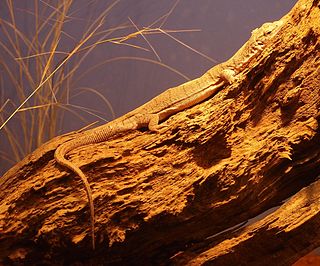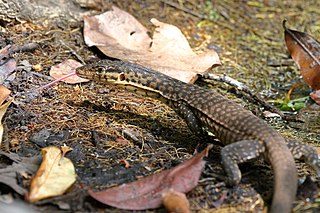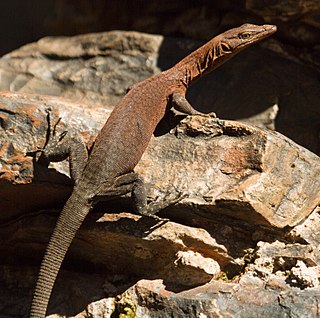
Monitor lizards are lizards in the genus Varanus. They are native to Africa, Asia, and Oceania, and one species is also found in the Americas as an invasive species. About 80 species are recognized.

The desert monitor is a species of monitor lizards of the order Squamata found living throughout North Africa and Central and South Asia. The desert monitor is carnivorous, feeding on a wide range of vertebrates and invertebrates.

The lace monitor or tree goanna is a member of the monitor lizard family native to eastern Australia. A large lizard, it can reach 2 metres (6.6 ft) in total length and 14 kilograms (31 lb) in weight. The lace monitor is considered to be a least-concern species according to the International Union for Conservation of Nature.

The yellow-spotted monitor, also known as the Argus monitor, is a monitor lizard found in northern and western regions of Australia and southern New Guinea.

The spiny-tailed monitor, also known as the Australian spiny-tailed monitor, the ridge-tailed monitor or Ackie's dwarf monitor, is an Australian species of lizard belonging to the genus of monitor lizards (Varanus).

The rock monitor is a species of monitor lizard in the family Varanidae. The species is endemic to Central, East, and southern Africa. It is the second-longest lizard found on the continent, and the heaviest-bodied; locally, it is called leguaan or likkewaan.

The stripe-tailed goanna, also known as the line-tailed pygmy monitor is a semi-arboreal species of monitor lizard native to Western Australia.

The pygmy mulga monitor, also known as Gillen's monitor or just mulga monitor is a species of lizard in the family Varanidae.

The Kimberley rock monitor is a medium-sized species of monitor lizard in the family Varanidae. The species is native to Northern Australia. Also known as Glauert's monitor or the Kakadu sand goanna, it belongs to the subgenus Odatria.

Spencer's goanna, also known commonly as Spencer's monitor, is a species of monitor lizard in the family Varanidae. The species is endemic to Australia.

The black-headed monitor or black-tailed monitor is a relatively small species of monitor lizards native to Australia. It is occasionally also called the mournful monitor, freckled monitor or the racehorse monitor, a name it shares with the Gould's monitor due to their exceptional speed. It is placed in the subgenus Odatria.

The Rosenberg's monitor is an Australian species of varanid reptile found in southern regions of the continent. They are large and fast predators with rugged bodies and long tails, having a combined length up to 1.5 metres, that will consume any smaller animal that is pursued and captured or found while foraging. They occur in the Australian Capital Territory, New South Wales, South Australia, Victoria, where it may be rare or locally common, and more frequently observed in Western Australia, where it is sometimes abundant.

The yellow-headed water monitor, also commonly known as Cuming's water monitor, the Mindanao water monitor, and the Philippine water monitor, is a large species of monitor lizard in the family Varanidae. The species is endemic to the Philippines. It thrives in mangrove, forest and water margins in tropical refuges, where it feeds on birds, fishes, mammals, and carrion.
The black-spotted ridge-tailed monitor, also called commonly the black-spotted spiny-tailed monitor, the lemon-throated monitor, the northern ridge-tailed monitor, Whites monitor, and the yellow-throated monitor, is a species of lizard in the family Varanidae. The species is native to Australia's tropical Northern Territory. It is listed as Least Concern on the IUCN Red List as it is considered common and not threatened. It was first described in 1987. It is also known as White's dwarf goanna.

Kings' monitor, also known commonly as Kings' goanna, Kings' rock monitor and pygmy rock monitor, is a small species of monitor lizard in the family Varanidae. The species is native to Australia.

The Palawan water monitor, Varanus palawanensis, is a quite large species of monitor lizard in the family Varanidae. The species is endemic to the Philippines.

Mitchell's water monitor is a semiaquatic species of monitor lizard in the family Varanidae. The species is native to Australia.

The Southern Pilbara rock goanna, also known as the Hamersley Range rock monitor, is a dwarf member of the family Varanidae.
The Pilbara rock monitor is a small member of the family Varanidae endemic to the Chichester Range in North West Australia.
Storr's monitor is a medium-sized species of monitor lizard in the family Varanidae. The species is native to Western Australia and Northern Australia. It belongs to the subgenus Odatria.


















